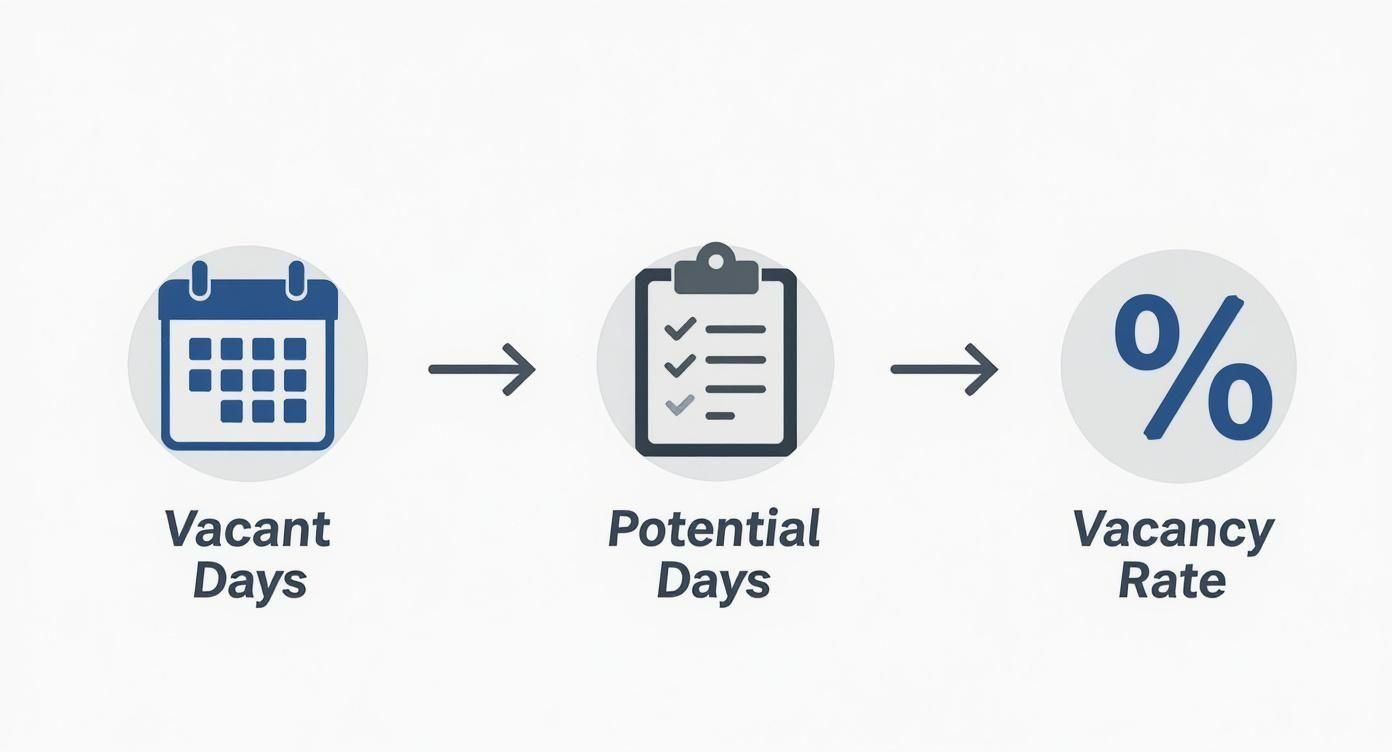How to Calculate a Vacancy Rate Accurately
How to Calculate a Vacancy Rate Accurately
Learn how to calculate a vacancy rate for your rental property. Our guide breaks down the formula, its impact, and how to use it for smart investing.
Domingo Valadez
Oct 27, 2025
Blog
At its core, the vacancy rate is a simple but powerful metric. You're just figuring out what percentage of the time your property sat empty when it could have been earning you money.
The calculation itself is straightforward: you take the total number of days a unit was vacant, multiply that by 100, and then divide it by the total number of days it was available to be rented.
Getting the Numbers Right
To get a truly accurate vacancy rate, you need to be precise about the two main ingredients in the formula. Sloppy tracking here will give you a fuzzy picture of your property's actual performance.
First, you need the number of vacant days. This is exactly what it sounds like: the total number of days a specific unit—or all the units in a property—was empty and available for rent within a set timeframe. For instance, if you have a 10-unit building and one apartment was vacant for the entire month of January, your vacant days for that unit would be 31.
The second piece of the puzzle is the total potential rental days. This is the absolute maximum number of days your property could have been occupied and generating income during that same period. Using our 10-unit building example, the total potential rental days for January would be 10 units multiplied by 31 days, which equals 310 days.
The accuracy of your vacancy rate hinges entirely on how precisely you track these two figures. A "guesstimate" can lead you to seriously misjudge your property's performance and even your position in the market.
To make this even clearer, here's a quick summary of what goes into the formula.
Vacancy Rate Formula at a Glance
This table breaks down the essential components for a quick reference.
Once you're comfortable with these two inputs, you're ready to plug them into the formula and see what the numbers are really telling you about your investment's health.
A Practical Walkthrough of the Calculation
Alright, let's put the theory into practice. Numbers on a page are one thing, but seeing how they play out with a real-world property is where the lightbulbs really go on.
Let's imagine we're underwriting a 50-unit apartment building. We need to figure out its vacancy rate over the last year to see how it's actually performing.
First, we establish our baseline: what’s the absolute maximum number of days all units could have been rented out? This is our "potential rental days."
- Calculation: 50 units x 365 days/year = 18,250 potential rental days
This big number, 18,250, is the denominator in our equation. It represents the total rental inventory we had to work with for the entire year.
Tallying Up the Vacant Days
Now for the detective work. We need to dig into the rent rolls and property management reports to count up every single day any unit sat empty. This is where meticulous record-keeping pays off.
For our 50-unit example, let's say our review uncovered the following:
- Unit 101: Sat empty for 45 days during a turn.
- Unit 205: Was vacant for all of March, which is 31 days.
- Unit 310: Underwent a renovation and was off-market for 60 days.
- Unit 402: A tenant moved out mid-December, leaving it vacant for the last 15 days of the year.
Add it all up: 45 + 31 + 60 + 15 gives us a grand total of 151 vacant days. This is the numerator for our formula.
This simple infographic lays out the formula we're about to use.

It’s a straightforward comparison of how many days were lost to vacancy versus how many were available in total.
Vacancy Rate = (Total Vacant Days / Total Potential Rental Days) x 100
Now, we just plug in the numbers from our building:
(151 vacant days / 18,250 potential days) x 100 = 0.83%
The annual vacancy rate for this property is a staggeringly low 0.83%. From an operator's perspective, this is a fantastic result. It signals high demand, efficient unit turns, and a very healthy asset.
But remember, this number doesn't live in a vacuum. A rock-solid, low vacancy rate is a huge piece of the puzzle when you learn how to calculate NOI, because it directly supports a stable, predictable income stream—and that’s what we’re all chasing.
What Your Vacancy Rate Is Really Telling You

Calculating your vacancy rate is one thing, but the real skill lies in understanding the story that number is telling you. Think of it less as a simple metric and more as a health check for your investment. It’s the raw, unfiltered truth about how your asset is performing right now.
A high vacancy rate is obviously a flashing red light. It’s a clear signal that something about your property isn't clicking with the market. Are your rents too aggressive for the area? Is your marketing just not reaching the right people? Or maybe the units are starting to look dated and just can't compete?
On the flip side, a rate that’s too low—say, consistently hovering under 1%—might feel like a huge success, but it often means you're leaving cash on the table. An extremely low vacancy rate is a classic sign that your rents are below market, and there’s a good chance you could be earning more.
How Vacancy Hits Your Wallet
That vacancy number isn't just an operational stat; it directly impacts your bottom line. Every single day a unit is empty, your Gross Potential Rent takes a hit, which in turn eats into your Net Operating Income (NOI).
This is especially critical in the world of commercial real estate lending. Lenders pour over your property’s financials, and a stable, predictable vacancy rate shows them strong demand and reliable cash flow. That makes your deal a much safer bet in their eyes.
Vacancy is a core assumption in any pro forma. When your actual vacancy outperforms your underwriting, you create real value. But when it underperforms, it can quickly erode your projected returns and threaten your entire investment thesis.
It’s also important to zoom out and see how your property fits into the bigger picture. For instance, some analysts predict the U.S. office vacancy rate could climb as high as 18.9% by the end of 2025 due to major economic shifts. You can get the full picture from the real estate market trends from CBRE. Comparing your asset’s performance to market-wide data tells a much richer story about its true health.
Comparing Vacancy Rates Across Different Property Types

Once you've got the vacancy rate calculation down, the real work begins: interpreting what that number actually means. A 5% vacancy rate might be a sign of a thriving, stable asset in one sector, but it could be a serious red flag in another.
There’s no universal "good" number. It's all about context and property type.
For instance, in the multifamily world, a vacancy rate between 4-6% is often considered the sweet spot. This range signals healthy demand but still gives you enough breathing room for natural tenant turnover and unit upgrades without tanking your income. When you're underwriting a deal, you have to consider the unique market dynamics of different residential and commercial investment opportunities.
Flip over to the commercial office sector, and you're playing a completely different game. These properties deal with longer lease terms and much larger tenants, so a single empty suite can have a massive impact on your cash flow. A healthy vacancy rate here is typically higher—think 8-12%—simply because it takes a lot longer to find and secure the right corporate tenant.
A Look At The Benchmarks
Every property type has its own rhythm and expected performance. What's considered healthy for a bustling apartment complex is completely different from a specialized industrial warehouse.
Typical Vacancy Rate Benchmarks by Property Type
Understanding these benchmarks gives you a crucial starting point for evaluating any potential investment.
Specialized Assets Have Their Own Rules
The story gets even more interesting when you look at niche real estate assets, where supply and demand can be incredibly tight. Data centers are a perfect example. The world's relentless need for digital infrastructure has pushed vacancy rates to historic lows.
For a real estate syndicator, benchmarking performance isn't about hitting a generic number. It’s about understanding if your 5% vacancy is excellent for your asset class or a sign of underperformance relative to direct competitors.
This dynamic is crystal clear in the global market. A recent report showed the average vacancy rate across sixteen major data center markets fell to a record low of 6.6%. In North America, it's even tighter at just 2.3%, thanks to massive demand from cloud providers and tech giants.
For an asset like that, a 5% vacancy rate would be a huge concern, likely pointing to a problem with the facility, its power infrastructure, or its location.
How Vacancy Rates Tell a Bigger Economic Story
It’s easy to think of vacancy rates as just a real estate metric, but the core idea—measuring "unused capacity"—is a powerful lens for looking at the entire economy. Once you grasp this, you see the same logic everywhere. Economists, for example, use an almost identical concept to check the pulse of the labor market.
This parallel metric is the job vacancy rate. Instead of tracking empty apartments, it counts unfilled job openings, and it’s a surprisingly accurate barometer for economic health.
The Macro View: Jobs Instead of Apartments
Think about it this way: a property's vacancy rate tells you about the demand for housing in that area. In the same way, the job vacancy rate reveals the demand for labor across the country.
When the job vacancy rate is high, it means businesses are on a hiring spree and can't find people fast enough. This is usually a sign of a strong, growing economy. It often foreshadows wage growth as companies start competing more fiercely for talent.
On the flip side, a falling job vacancy rate can be an early red flag for an economic downturn. It suggests businesses are getting nervous, slowing their expansion plans, and hiring less. This often happens just before unemployment numbers start to climb.
Seeing vacancy rates work on a macroeconomic scale really hammers home the point. At its heart, the calculation is just a pure, simple measure of supply versus demand—whether you're talking about physical space or human capital.
This isn’t just a theoretical exercise; major economic bodies rely on this data. Eurostat, for instance, calculates the job vacancy rate by looking at the number of job openings relative to all occupied and unoccupied jobs.
In the second quarter of 2025, the job vacancy rates were 2.2% for the EU and 2.4% for the euro area, which pointed to a slight cooling-off in labor demand at the time. If you're a data geek, you can dive deeper into these trends and explore more job market findings on Eurostat's official site.
Digging Deeper into Vacancy Rates
Once you've got the basic formula down, the real-world questions start popping up. Let's tackle a few of the most common ones I hear from investors to help you sharpen your analysis.
Physical vs. Economic Vacancy: What's the Real Difference?
This is a big one, and understanding the distinction is non-negotiable for serious underwriting.
Physical vacancy is the simplest way to look at it—it’s just the number of empty units. If you have a 10-unit building and one apartment is empty, your physical vacancy is 10%. Simple enough.
But economic vacancy tells the real story of your cash flow. It accounts for all the ways you might be losing income, even from units that have someone living in them.
This includes things like:
* The physically empty units, of course.
* Giving a new tenant "one month free" as a concession.
* A tenant who has stopped paying rent but hasn't been evicted yet.
When you're putting together a deal, economic vacancy is the number that matters. It reflects the actual cash that isn't making it to your bank account, which is a much more accurate measure of performance.
Should I Track Vacancy Monthly or Annually?
The short answer? Both. They just serve different purposes.
Your annual vacancy rate is what you'll use for your pro forma, for getting financing, and for reporting to your investors. It’s the industry-standard number that smooths out the bumps and gives a stable, high-level view of the property's health over the long term.
A monthly vacancy calculation, on the other hand, is your early warning system. It's an internal tool for asset management. If you see a sudden spike one month, it tells you something is wrong right now, letting you dive in and fix the problem before it torpedoes an entire quarter's performance.
Pro Tip: I like to think of the annual rate as the compass for steering the ship (big-picture strategy) and the monthly rate as the radar for avoiding icebergs (day-to-day tactics).
How Can I Actually Lower My Vacancy Rate?
Bringing that number down really boils down to two things: attracting great new tenants and keeping the ones you already have. It’s a two-pronged attack.
First, you have to nail the fundamentals. Is your pricing right for the neighborhood? Is the property clean, safe, and well-maintained? If you’re priced too high or the curb appeal is lacking, you’re fighting an uphill battle from the start.
For retention, it's all about being a great landlord. Quick, responsive communication when a tenant has an issue is huge. Being proactive with lease renewals well before they expire also works wonders. Remember, every time a tenant moves out, you're hit with turnover costs and the potential for extended vacancy. Keeping good tenants happy is almost always the most profitable strategy.
Share On Linkedin
Share On Twitter
Share On Linkedin
Share On Twitter
DOMINGO VALADEZ is the co-founder at Homebase and a former product strategy manager at Google.
What To Read Next
Your Guide to Real Estate Investing for Cash Flow
Blog
Unlock the secrets to building wealth with real estate investing for cash flow. Learn how to analyze deals, secure financing, and scale your portfolio.
Sign up for the newsletter
If you want relevant updates from our team at Homebase, sign up! Your email is never shared.
Sign up for the newsletter
If you want relevant updates from our team at Homebase, sign up! Your email is never shared.
© 2025 Homebase. All rights reserved.